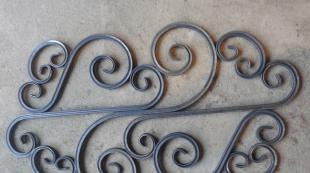How to unscrew the fixing screw. How to unscrew a screw if it does not get out
A screw, screw or self-tapping screw that does not get out of the material is a common problem, and during repair work almost everyone has experienced it. There are many reasons for this phenomenon. For example, it can be a defective fastener, damage to the splines due to the inexperience of the performer, or a worn out tool that does not provide tight contact with the part being twisted. Sometimes it seems that it is no longer possible to remove the jammed fasteners, they are stuck so tightly, but the task is completely solvable.
1. Tool change

With the screwdriver constantly jumping off the slots, the reason may be the wear of the sting. In this case, the tool is replaced. A new screwdriver is inserted into the screw head, making sure that the tip is pressed tightly against the slot, firmly entering the grooves, and they try to unscrew the fastener.
Helpful advice from the site: In the case when the fasteners cannot be unscrewed, the first thing to do is to stop. Attempting to continue unscrewing can aggravate the situation, and a screwdriver that constantly jumps off can damage the material. Assess the condition of the screw and try other extraction methods.
2. Pliers

If the stuck screw or self-tapping screw is not fully tightened and the top protrudes above the surface of the fastened part, you can try to remove it with pliers or pliers. Carefully, so as not to damage the material, the clamps of the tool grab the head of the fastener on the sides. Then it is slowly unscrewed by turning it counterclockwise.
3. Drill

A screw that has not completely gone into the material can be tried to be pulled out with an electric drill or screwdriver. The tool chuck is opened, put on the screw head and the clamping mechanism is tightened, securing the head in the chuck. Then set the reverse mode and carefully turn the screw out of the material. This works with almost any type of threaded element or jammed bolt, as long as there is a part of the head that the cartridge can catch on.
4. Auxiliary material
If the fastener is completely recessed, you can try to improve the grip of the cap and the screwdriver with some kind of material. It can be a piece of the abrasive layer of an ordinary kitchen sponge or adhesive tape pasted on a defective hat. But it is best to use a strip of rubber or leather. It can be of any width, although a piece of such dimensions is desirable that will cover the head of the screw completely. This will provide a large contact area between the head and the tip of the screwdriver or screwdriver bit. A piece of rubber is placed on the head of the fastener, a screwdriver is applied and they try to unscrew the stuck part.
5. Edge notch

In the case of a torn off screw head or worn edges, you can make an incision on the head for a better stop of a flat screwdriver. The notch is applied using a dremel, grinder or other metal-cutting tool. However, this method will damage the surface of the material if the screw sits too deep.
Helpful advice: If the material allows, you can use the property of the metal to expand when heated and contract when cooled. Stuck fasteners are heated with a lighter, soldering iron or building hair dryer. The screw will slightly increase, bursting the material, and when it cools down, it will return to its previous state. As a result, a microscopic gap may appear between the rod and the material, which will slightly loosen the fastening and make it easier to unscrew.
6. Extractor

If the previous methods did not work, you can use an extractor. It has the appearance of a metal rod with a screw thread and is designed specifically for unscrewing stuck bolts and screws. Before using the tool, a vertical hole is drilled in the screw with a thin drill. The screw end of the extractor is inserted there and at first it is slowly turned, achieving a strong fixation. Then unscrew the screw.
The advantage of this method is that it does not damage the material from which the seated fastener is removed. Almost all types of fasteners can be unscrewed in this way, with the exception of self-tapping screws made of hardened steel. In such material it is almost impossible to drill a thin hole for the extractor, the drill will go to the side.
7. Nut and wrench

Another solution to the problem is to glue a nut to the top of the screw or screw. This can be done by cold welding or hot, if skills allow. After hardening, the screw is unscrewed with a wrench.
8. Cork drill

If the screw is so deep in the wood that there is no way to get close to it, but you need to remove it, you can use a cork drill. It makes neat holes and uses it to remove material around the stuck fastener.
9. Drill out completely

When all of the above methods have failed, the cardinal method of removing stuck fasteners remains. The screw or screw is drilled out completely, to the base. Then a new fastener of a larger diameter is inserted into the hole.
Practical advice: When removing a stuck fastener, safety precautions must be observed. During the drilling process, metal chips are generated that scatter to the sides, and if they get into the eyes, injury can result. At the end of the work, the chips are removed with a brush or sponge so as not to damage the skin on the hands.
All of us have faced a similar problem. Convulsive movements with a screwdriver in an attempt to remove a screw with a damaged slot only exacerbate the situation. The reasons why the notch was broken can be different, ranging from haste / haste to “gifts” that were so kindly provided by the repairmen that they unsuccessfully tried to finish what was planned!
Removing broken fasteners requires a little ingenuity, but the goal is noble and worth realizing. Here are 5 reliable methods for removing stripped screws, let's start with the most gentle method and move on to the method that can be called "cheap and cheerful." The method you choose will depend on your situation and the importance of removing stubborn fasteners.
Let's not let screws ruin our day. Let's unscrew them !
Step 1: Rubber band (elastic band)

Sometimes all it takes to get a stubborn screw out is a little more contact area. The elastic band will help keep the tip of the screwdriver in the cap with a broken slot and prevent scrolling.

You can take any elastic band, but a wide one is better. Since it provides the largest contact area between the cap and the screwdriver.

Put the elastic band over the screwdriver and pull hard enough so that it does not sag, then carefully place the screwdriver in the broken slot and slowly turn it.

If the slot is not completely “stubbed”, the rubber band will fill in the space where the notch is broken and provide the necessary friction, which will allow the screw to be removed.
Step 2: Clamp the screw into the screwdriver chuck

If the screw is not fully embedded in the material, there is a good chance that you will be able to clamp it into the drill/driver's chuck and back out easily.

Open the chuck and place it on top of the screw head. Next, tighten the chuck by hand so that the "cams" are securely fixed on the screw. Set the Shurik / drill switch to reverse and slowly unscrew it from the board.

This works with any type of screw/screw/bolt that has a head size that allows it to be clamped in the chuck.
Step 3: Broken Screw Extractor

If you come across an extremely stubborn fastener that just won't come out, it's time to call in the heavy artillery.
Screw extractors have a left-hand thread, and screws have a right-hand thread.

Extractors come in different sizes. Need to pick up right size for screwing into a broken slot. Install the extractor in the chuck of the screwdriver and tighten the chuck securely.
Set the drill switch to reverse. Since the extractor is reverse threaded, this means that a drill with an extractor set to reverse will drill into the head. By continuing to drill in the opposite direction, the extractor will begin to turn the screw, thereby unscrewing it from the board.

Step 4: Cut a New Slot

Another way to unscrew a stubborn fastener is to put a new notch on the head of a stripped screw.

It happens that a screw or screw that has a countersunk or semi- countersunk and round head, where there is a tightly torn off cross-shaped or straight slot, and the screw or screw is tightened to the surface end-to-end - in such cases you will not be able to take pliers and pull it out.
It is not permissible to damage the surface to which the screw is screwed - it is not at all an option to choose material from under the head so that it can be fixed with pliers. Moreover, it is not allowed to use a crowbar, as in the case of nails.
Now we will look at some solutions on how to unscrew a stripped screw.
What do we do first
When your screwdriver slipped over the edges for the first time, you need to stop and not try to unscrew it again. Usually in such cases the situation is aggravated and leads to great difficulties. The first priority is to preserve the head in which the screw is located.
First you can try to take another screwdriver. It may happen that the screwdriver just does not match the screw you have chosen. Using other screwdrivers, you need to make sure that the tip of the screwdriver clearly entered the hat. If there is no sense in changing tools, then you need to move on to other, more effective methods.



How to just unscrew a licked screw
All you need to prepare for this is a small piece of rubber or rubberized material. You can use a medical tourniquet, rubber from a bicycle or car camera, a rubber ball, etc.We take what is at hand and cut out a small rectangle. You need to put it on the licked screw, then rest it with a screwdriver and carefully, slowly start to unscrew it.
This is a very simple manipulation, but here it is important to direct the effort to pressure from above on the self-tapping screw.
After making a few turns, edges can be printed in a piece of rubber, after which the screwdriver will scroll. We shift the gum to a new surface and continue to unscrew the screw further.

I did this operation using a tourniquet and a bicycle inner tube folded in half. As a result, everything gets out without question.
Video of how it's done:
Using the extractor
You can use an improved way to unscrew a torn screw - using an extractor. They resort to his help mainly when it is necessary to unscrew a broken screw. In this case, when unscrewing it, it will not break.
The extractor is the same screwdriver, only with a difference in the form of strong and coarse metal threads located on the tip. They allow you to easily get into the head of the screw and eventually unscrew it.

Extreme measures and maximum results
It may happen that the above methods did not give any effect. In this case, the screw can be drilled out completely to the base. This method can also be used when the screw cannot be unscrewed through the stripped thread. In such a situation, when drilling, the thread is completely destroyed, and the screw is easily removed from the workpiece. Then a new screw can be used instead, only with a larger diameter.
The problem of licked edges of a Phillips screwdriver has long been known to everyone. There are few solutions to how to get out of this situation and remove the broken screw. I will only offer you seven that I personally had to use.
How to unscrew the licked screw?
Unfortunately, there is no almost universal solution. And each presented method is good for its situation. Therefore, everything is known in comparison and applied to a specific individual situation and its screw.First method: use a tourniquet
You will need a piece of thick rubber. It can be a piece of a medical tourniquet, a piece of a camera from a bicycle, or the like. The denser and stiffer the material, the more twisting force can be created.Berm a screwdriver as close as possible to the groove of the screw.

We take a tourniquet.

We put the tourniquet under the screwdriver or bit and insert it all into the licked head. Next, with simultaneous pressure and rotational movement, we try to unscrew the screw.

Properly applied force can unscrew the screw with a significantly screwed-in force.
The second way: how to unscrew the screw with an impact screwdriver
If you have an impact screwdriver (or ask your friend), you can use it.
Of course, the screw cannot be completely unscrewed, but the connection can be significantly loosened, and then we use a regular screwdriver.

The third way: we use a special bit for bolts with ground crosses
Since the problem of licked edges is not new, the market has long been sold turnkey solutions. For example - a special bit for unscrewing licked bolts.
We insert it into a screwdriver or screwdriver and unscrew it. Sharp edges at the right angle engage perfectly and the screw can be rotated.

Fourth way: extractor
An extractor is a special tool designed to repair broken screws, studs, bolts and the like. It works exactly like the bit in the example above, but with a slight difference.We insert the nozzle into the screwdriver and unscrew. You may first need to select the extractor according to the recess, since the diameters of the heads are different.


Fifth method: unscrew with the left drill
On sale, in addition to the usual drills for all of us, there are also drills with a left-hand helix. Such a drill can be used as a tool for unscrewing a broken screw.
Sixth method: use a core
This method is well suited for removing small screws. We take the core, rest it against the edge of the cap at an angle of about 45 degrees and gently hit it with a hammer in the direction of the cap rotation.
The core, due to its sharpness, has good engagement, which means that the screw is more likely to be unscrewable.

Seventh method: take a hammer and chisel
The method has become a classic, but it is problematic to use it for small screws. We take a chisel or chisel, remove the tip to the side of the cap and gently hitting turn the screw. The main thing here is to move the hat from its place, and as it seems, unscrewing can be continued with pliers.
Friends, it will be very great if you share your ways of how to get out of such a life situation. Thank you for your attention! For more information, see the video.
Over time, the fasteners rust, so it is impossible to unscrew them with the help of improvised means, without making any effort. Many people face this problem. This is especially true for motorists, owners of private houses, where various iron structures are forgotten on the street, as well as those who start repairing and replacing old plumbing. It may seem too difficult for some, in fact, there are many ways to remove rusted nuts, bolts and screws without damage.
Causes of the problem
Rust can destroy any surface, especially metal. It appears if the part is in contact with water for a long time, salt, various contaminants get on it. Even ordinary dust can cause friction of the elements and exacerbate the situation. Any metal product has a special protective coating. If it has been damaged, then corrosion will form, due to which the mount ceases to perform its functions. Some metals do not react well to contact with oxygen or chemicals, which also causes rust.
To unscrew the mount, you need to create microscopic cracks in the rusty crust
Preparatory work
To reduce friction, aids must be used. At the same time, they must have such a consistency that they can get into any, even the smallest hole. There are many on the market special means which will make your work easier. WD-40 liquid, which is available in the form of aerosols, has proven itself to be excellent. If it was not in the store, buy kerosene, turpentine or diesel fuel. It is enough to apply the product on the thread and leave it for 15-20 minutes.
Advice! Do not use lithol or grease, as the substance subsequently hardens, which makes it impossible to unscrew the fastener.
Versatile anti-rust material
Ways to unscrew rusted parts at home
Dismantling with a socket or ring wrench
If the rust layer is not too large, use an end or ring spanner. In this case, the tool must have 6 or 12 points of contact. Next, you need to alternately tighten and loosen the thread with fairly sharp movements. If this does not help, work the surface with a wire brush, and then apply one of the lubricants mentioned above. After the tool has started to work, take a hammer and lightly tap on the mount to knock off the top layer. Then use the key again, the clamp should loosen. To enhance the effect, you can put a pipe on the key or use a tool without a ratchet mechanism with a long handle. But be careful in your work, bad and old tools can break right in your hands.
Do not use brute force, otherwise the threads may be stripped.
Use muscle strength and this tool
Exposure of nuts and bolts to high temperatures
Alternatively, heat can be used to remove the part. Take a blowtorch and heat the mount with it. It is important to heat only one side of the bolt or nut so that it expands from high temperature and damaged the rust layer. If such a tool was not at hand, you can use an ordinary candle. After heating, pour over the part cold water, and then pick up the key again. The only disadvantage of such methods is that they spoil the hardening of the metal.
Do not use this method near flammable objects and rubber seals
Important! Some manipulations can be dangerous, so take precautions!
How to unscrew with a screwdriver using a mixture of gearbox oil and acetone
An effective mixture is prepared with my own hands. It consists of 50% automatic transmission oil and 50% acetone. It is necessary to use the lubricant several times over several hours, each time leaving it for at least 40 minutes. Sometimes the bolt is intended for a screwdriver, in which case take the same tool or a chisel and a hammer. Then, with the help of blows, try to loosen the fasteners. If you are not afraid of extreme methods, use zinc or sulfuric acid. Initially, you need to make a small rim of plasticine or wax around the fasteners. Then put a piece of zinc into the formed recess, pour a chemical element on top. In a day the problem will be solved. In the same way, you can unscrew the stuck screw on the mixer.
Twisting all the way
An important way is the so-called "method of the contrary": in order to loosen the fastening of a stuck part, you should not unscrew it, but on the contrary, try to twist it tighter to the end. So the course of the bolt or nut will become freer, which will ultimately help in removing the rusty mount.
Complete dismantling
If all these methods were unsuccessful, then the mount will need to be destroyed. This can be done in several ways. If you are working with a bolt, you need to drill it out and cut a new thread. You can also use a special tool, such as a nut puller. It tightens the part, it cracks under pressure, so that the nut can be removed with an ordinary wrench. The most radical way is to use a grinder. It is enough just to cut the bolt along using a metal disc.
Prevention - the best way rust control. Always tighten fasteners to the same torque rating for similar threaded connections, use good quality bolts, nuts and screws, and lubricate the part before tightening. Even if the part is new, it is better to clean it again. All this will avoid the moment when you have to resort to shock methods.
All the methods described above are quite effective, so you can safely use any of them. They have been tested by different masters and always gave a positive result. Using these tips, you can easily overcome the difficulties of stuck screws, bolts or nuts. And by taking preventive measures into account, you can avoid the recurrence of the problem.









